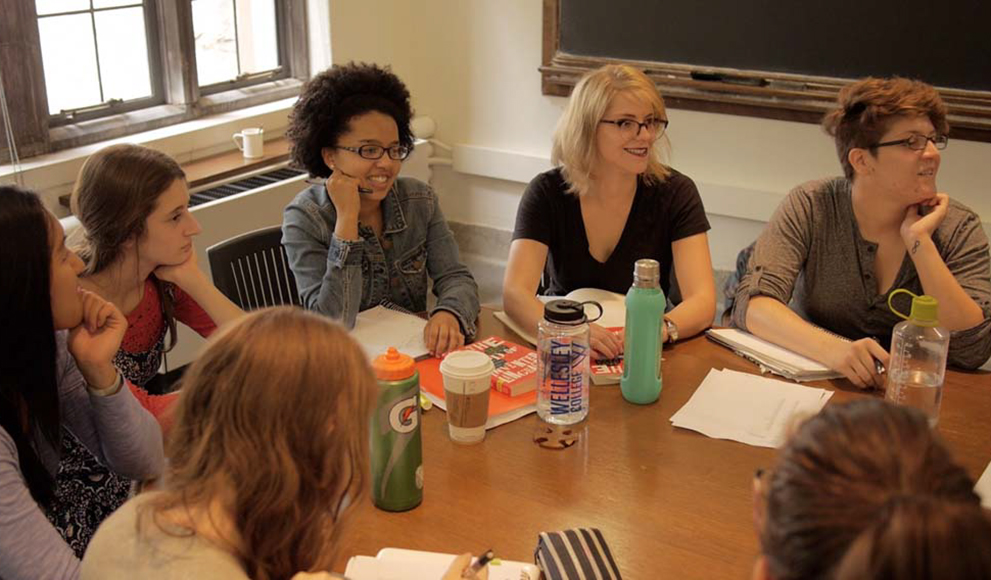Students in Professor Angela Carpenter’s ‘Invented Languages’ Course Create New Worlds Through Language

When a recent New York Times story explored college courses centered on invented or constructed languages, known as "conlangs," Wellesley College was one of only a few schools noted. Known for excelling in the teaching of language and languages, it is no surprise that Wellesley would be breaking ground by developing one of these unique and challenging courses. Angela Carpenter '99, assistant professor of cognitive and linguistic sciences, developed the Wellesley course: Invented Languages: From Wilkins' Real Character to Avatar's Na'vi. She has taught the three-hundred level course four times to date.
As the Times noted, students in courses such as Carpenter's "take apart the words, sounds, writing and patterns of such conlangs as Dothraki [from Game of Thrones], Na'vi (Avatar), Elvish (Lord of the Rings) and Klingon (Star Trek)" and learn "how languages evolve to meet the needs of their speakers." Carpenter's class requires students to create a fully functional language of their own making.
As a capstone, the course "pulls together every little thread," said Carpenter, including phonetics, morphology, syntax, semantics, and typology. "There's nothing like having to come up with everything from scratch," she added, "and of course it ties together language and culture." Students bring their own creativity to the semester-long endeavor when they build a lexicon of invented words, an inventory of sounds, and a set of rules that govern it all. But that's only part of the process.
"Languages don't exist outside of cultures," Carpenter tells her students, "and the sounds are going to reflect the culture as well." This means students must also imagine and develop the invented speaker's culture and theorize how their language and culture affect each other. One of her students imagined a culture whose speakers had two dialects, one they used in anger and one in peace. Yet another student imagined a planet with such a slow rotation that an individual would live an entire life and never see daylight. (This student even asked a professor in the astronomy department if such a planet could theoretically exist; it could.) As one might guess, her created language had a very unique relationship to all words related to light and dark.
Sam Burke '14, who majored in linguistics and German, and Mollie Krawitz '17, a Russian language and literature major, both offered praised for the course, specifically the way Carpenter guides her students through the process of language creation.
"Professor Carpenter chose a series of texts and readings to help us understand and embody language creation, as there are no college textbooks on invented language creation," Burke explained. "She then constantly nurtured our individual languages. Each week she encouraged us to share [with the class] what we had created and to use both our imaginations and linguistic resources to delve further into our [language's] design."
At the end of the term each student in class presents and teaches their invented language to their peers, often reciting or poem, song, or story. "I have never been more in awe of what a Wellesley class had created and what Professor Carpenter supported us in creating," said Burke, recalling these presentations.
Students in past courses have also been treated to special guests. Krawitz recalled a class visit from David J. Peterson, the man who created two of the languages for the wildly popular HBO program Game of Thrones. "Professor Carpenter had each of us read a sentence in our own language," Krawitz said. "[Peterson] gave us constructive and encouraging feedback; it was an invaluable experience to talk to a professional 'conlanger' [constructed language creator]." Peterson recently agreed to publish Carpenter's students work on his archive of scholarship on ‘conlangs, called Fiat Lingua.
The class also discusses the history of invented languages. The first constructed language dates back to the 12th century, according to Carpenter. The title of the course, in fact, refers to John Wilkins' 1668 publication of a constructed language he hoped would become a universal language for scholars. Krawitz said this part of the course was especially engaging. "The class is fascinating because we learn about 'conlangers' throughout history—their dreams, their methods, and the results, however successful or unsuccessful they were," she explained.
Carpenter admits she was attracted to teaching the course because "the whole enterprise is such that [the students are] living in this whole world [of questions like] 'What is a language?' and 'What do I want my language to communicate?'" She added, "They get a chance to explore the possibilities of language and get intrigued by the human mind and what it's capable of—how these languages have evolved and changed and accommodated what we’re capable, and how our language can help expand our thinking."
